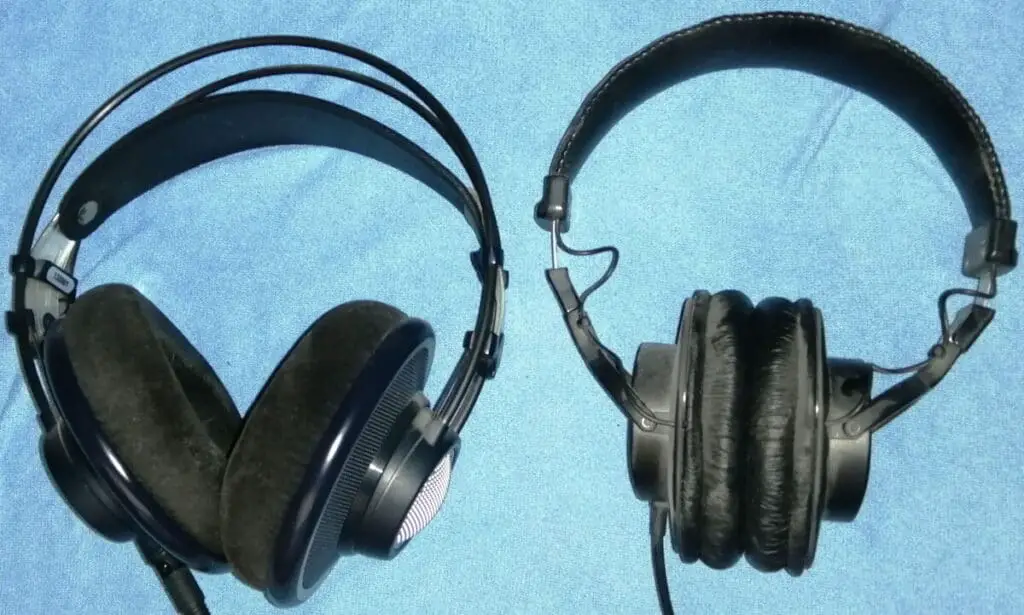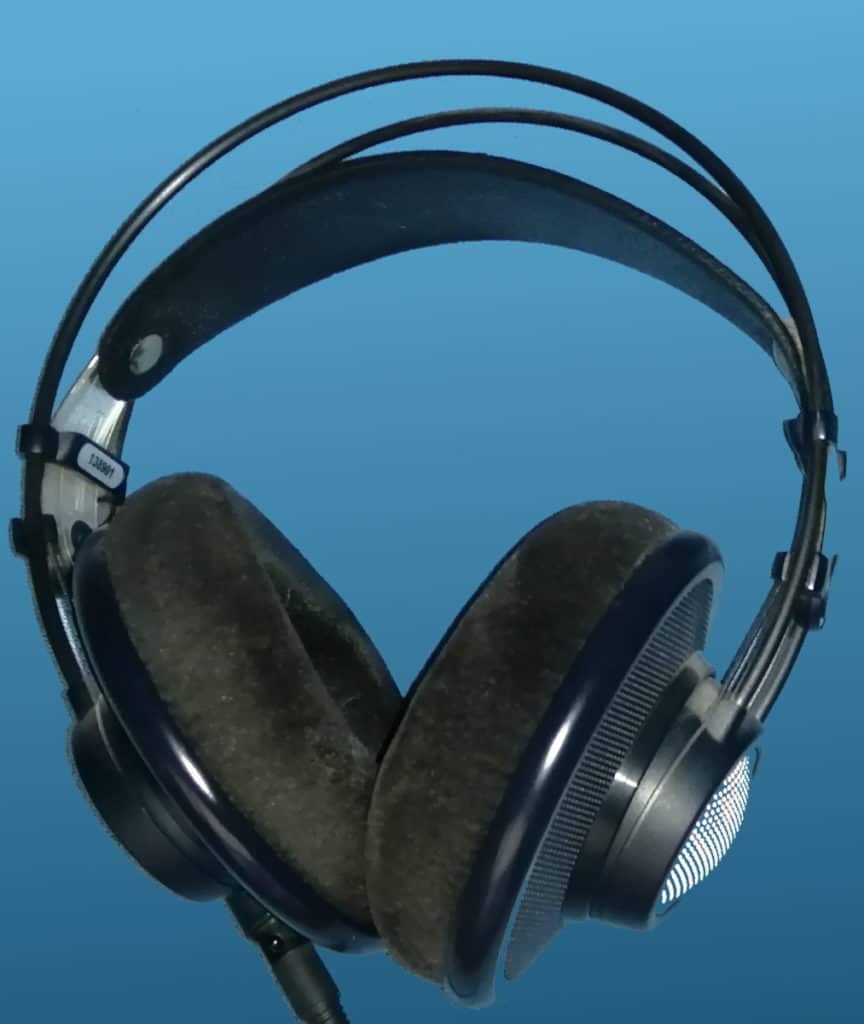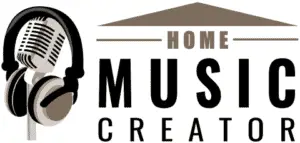
I own multiple pairs of headphones. Some of these headphones I use solely for certain music production activities. Others are general use “normal” headphones. However, there are circumstances when I will use the “normal” headphones for some music production tasks, where they are particularly suited to the task at hand.
Normal headphones can be used successfully for some music production tasks. These tasks are typically where very accurate reproduction of the sound is not necessary, e.g. editing or arranging. Other tasks require studio headphones to provide very high-fidelity sound reproduction e.g. mixing.
As with most things, the trick is in choosing the correct tool for the job. Read on to find out which music production activities can reliably be done with normal headphones, and which really require studio headphones to do the job properly.
If you are interested in checking out the best recording gear such as audio interfaces, studio monitor speakers, microphones, etc., you can find them at Amazon by clicking here.
Studio and normal headphones: what’s the difference?
Studio headphones are generally designed for one thing; to give an accurate representation of the sound.
Don’t all headphones try to do that? No, not at all!
Normal headphones are designed to make the music sound good.
Read those two statements carefully. It’s the difference between headphones that are aiming for accuracy, and those that are aiming for a good sound. They are not the same thing. The normal headphones may try to enhance the sound in some way to make it better, whereas the studio headphones present the sound to you as-is without any modification.
Studio Headphones
These give an accurate representation of the sound – a so-called flat frequency response. This is so you can hear what your music actually sounds like, warts and all.
Imagine you are mixing one of your songs. You need to hear all the components of the song clearly so that you can make decisions on what you hear.
If, for example, you hear that the bass is loud and overpowering, you may decide to reduce the amount of bass frequencies in your mix. For you to judge this right, your headphones need to be giving you a true picture of how much bass is in your song.
If your music sounds bad, you want the headphones to tell you it sounds bad!
Normal Headphones
Normal headphones are designed for consumers to listen to music and other sounds. Their aim is to make whatever sound they produce sound as good as possible.
This means that they may change the sound in an attempt to improve it. They may include technology to enhance the sound they produce. One of the most common of these technologies is a “bass enhancement” feature found on many consumer headphones.
These may improve the sound, which is great if you are just listening to music. But if you are trying to create music and make objective decisions about it, this is not desirable. The headphones are effectively lying to you about your music.
When you can use normal headphones in music production
It is perfectly acceptable to use normal headphones for music production tasks where the accuracy of the sound isn’t that important. For example…
- Editing audio
- Editing MIDI
- Arranging
- Songwriting/composing
There is no real advantage to using dedicated studio headphones for those tasks.
Normal headphones can also be used for recording, in certain circumstances. As long as the sound from your headphones doesn’t end up going into the microphone you are recording (so-called bleed), you should be fine. When you are not using a microphone to record, this isn’t a problem e.g…
- Recording a DI’d electric guitar using an amp sim (software guitar amplifier simulator)
- Recording MIDI from a keyboard/synth
There is one music production task for which you actually need your normal headphones; studio headphones would not be suitable….
That is checking what your mix sounds like on a variety of different sound systems, including normal consumer headphones. It is good practice to do this once you have a mix of your song – listen to it on a car stereo, a BlueTooth speaker in the kitchen, the living room hi-fi, a pair of cheap earbuds, your phone, etc.
When you should not use normal headphones in music production
One word – mixing.
There is some controversy over whether mixing should be done in headphones at all. Some say you should never do it, some say it’s fine as long as you have a good pair of studio reference open-back headphones. I am in the latter camp – I have successfully produced many good mixes on headphones.
Certainly, normal headphones should never be used for mixing. They do not give you an accurate enough representation of your music for you to make the musical choices you need to in mixing. This can lead to you actually making your song sound worse instead of better.
This is a complex and somewhat controversial topic! For more details check out my article on why it’s considered bad to mix on headphones. You will get a good understanding of the pros and cons, what to do and the equipment to use to ensure the best possible results if you do choose to go down this route.
As a side note, I also wrote a beginners’ guide to mixing in general. I highly recommended you check it out if you are new to mixing. It will clear up some of the confusion mixing novices often have, and take you right through the process of making your first mix.
The two types of studio headphones

You may have read through this article, and decided to buy a pair of studio headphones. There are actually two types of studio headphones, and they are suited to different uses.
Open-back headphones
Open-back headphones are known for providing the most accurate sound. The backs of the headphones actually are partially open to the air – they let some sound leak out. This is a quite deliberate design, as it leads to a more realistic, open sound closer to listening on speakers.
This accuracy and realism mean open-back headphones are perfect for mixing.
If you are looking for a pair of headphones suitable for mixing, I have been performing my mixes for many years on a pair of AKG K-702s. I have mixed 3 commercially available EPs using these, and can highly recommend them for sound accuracy and comfort. You can purchase the AKG K-702 Reference Headphones (affiliate link) through Amazon for a competitive price.
As open-back headphones are partially open, they leak sound out of them. This makes them less suitable for monitoring while recording, as the sound can bleed out of the headphones back into the microphone.
If you are interested in more details on the pros and cons of using this type of headphone for recording, then I highly recommend you check out my article on recording with open-back headphones. It details exactly what you can and can’t realistically do with open-back headphones in your studio.
This leads us on to the second type of studio headphones…
Closed-back headphones
As their name suggests, closed-back headphones are completely closed except for the part of the earpad that sits on your ear. This is the only part that emits sound.
This makes them perfect for recording – no sound escapes into the microphone as can happen with open-back headphones.
They do not have the accuracy or realism of open-back headphones, making them less suitable for mixing.
My favorite headphones for recording are the Sony MDR-7506s, which I have been using in my home studio for many years. You will usually find a pair or two of these in most pro recording studios. You can buy Sony MDR-7506 headphones from Amazon (affiliate link) for a great price.
If you do choose to shell out some hard-earned cash on a pair of studio headphones, you may well want to use them for ordinary day-to-day listening to music as well. That’s why I wrote my article asking can you use studio headphones for music listening. Check it out for the details on using your studio headphones for normal everyday listening tasks.
Should I buy studio headphones, or use my normal ones?
I have both closed and open-back headphones in my home studio. I use the closed-back pair for recording, and the open-back pair for mixing.
I would suggest you could use normal headphones on most occasions that the closed-back pair would be used e.g. recording, arranging, editing, etc. You could get away with using these instead of a closed-back pair without any problems.
For tasks where you need to hear the music very accurately such as mixing, normal headphones are not suitable. If you are going to mix on headphones, I would highly recommend that you buy yourself a pair of good quality open-back studio headphones such as the AKG K-702s mentioned earlier.
Finally, if you are reading this article you are clearly interested in gear that transmits the audio into your ears. So you might also be interested in these articles on studio monitor speakers – check them out…
- Can you really record without studio monitor speakers?
- Are studio monitors good for listening to music?
Here is some of my favorite home studio gear…
Thanks for reading this article. I hope you found it helpful in your home music-making activities. Here are a few of the tools that I personally use in my home studio. These are affiliate links, so if you decide to use any of them I’ll earn a small commission.
Audio interface: My personal choice for audio interfaces are the Focusrite Scarlett series. I have been using these for years, and they have always given me great-sounding recordings. For a very reasonable price from Amazon you can buy the excellent Focusrite Scarlett 4i4, or if you don’t need MIDI capability the Focusrite Solo is a great choice.
Amp sim: Guitar amplifier simulator software has come on leaps and bounds in recent years, such that I record all my electric guitar parts using amp sims these days. One of the very best is the incredible Amplitube from IK Multimedia, which I have used on many of my songs.
Headphones for recording: My favorite headphones for recording are the Sony MDR-7506s, which I use for monitoring during all my recording sessions. They can also be found in many pro recording studios. Get the Sony MDR-7506 headphones from Amazon here.
General-purpose microphone: You can’t go wrong with a good ol’ Shure SM-57, one of the most versatile and ubiquitous microphones around. I’ve been using one in my home studio for as long as I can remember. Amazon offers the Shure SM-57 for a very competitive price.
To see all of my most up-to-date recommendations, check out this resource I made for you!


